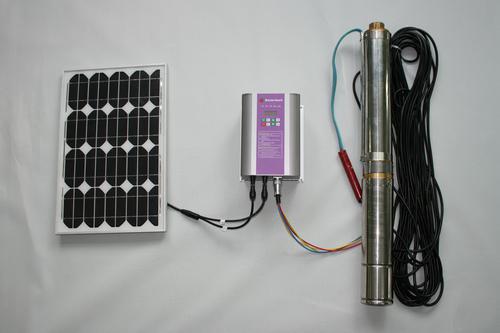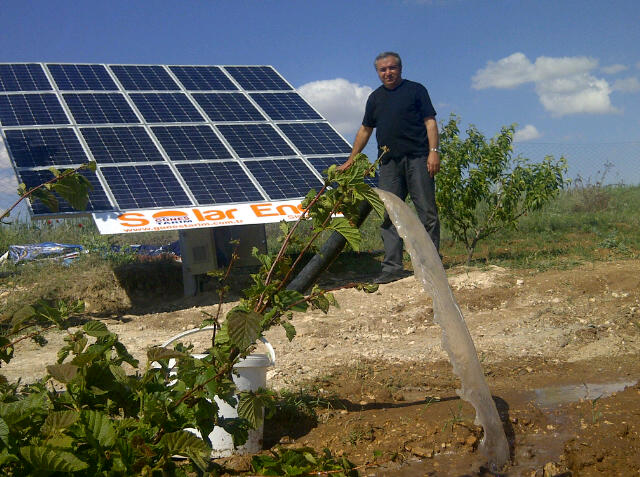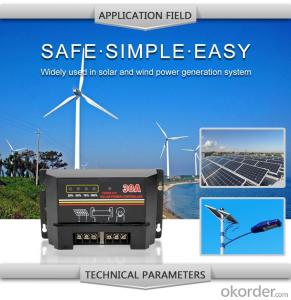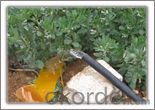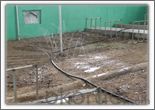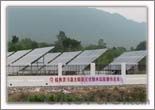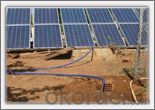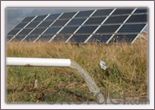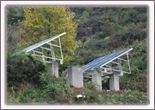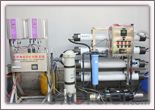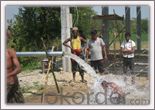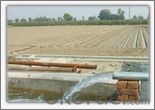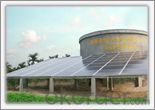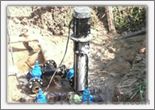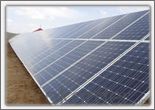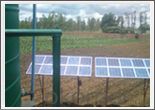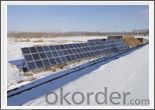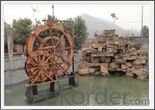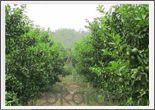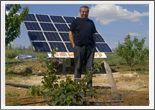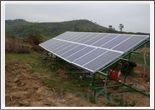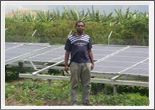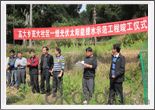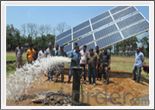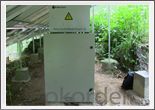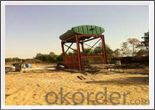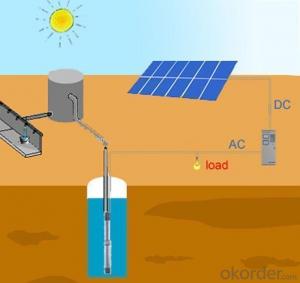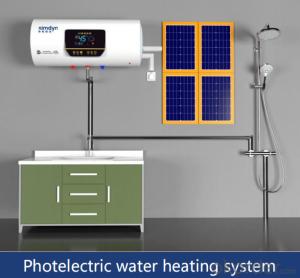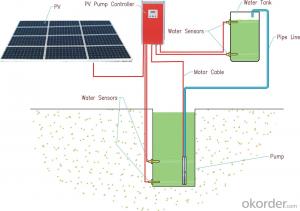PF Solar Pumping Inverter Water Pump Inverter
- Loading Port:
- Shekou
- Payment Terms:
- TT OR LC
- Min Order Qty:
- 20 set
- Supply Capability:
- 500000 set/month
OKorder Service Pledge
OKorder Financial Service
You Might Also Like
Solar Inverter Introduction:
Solar pumping inverter converts DC current from the solar array into AC current to drive the pump. With the function of MPPT (maximum power point tracking), it regulates the output frequency according to irradiation in real time to achieve the maximum power.
Solar Inverters Features:
1. Adopting the proposed dynamic VI maximum power point tracking (MPPT) control method; Fast response and stable operation; Better than the conventional methods which may lead to the problems including poor tracking performances, unstable or even cause water hammer damaging when the irradiation on the array changes rapidly.
2. The solar pumping inverters system is dispensed with energy storing devices, and stores water instead of electricity. It improves the reliability of the device, at the same time, it lowers the construction and maintenance costs of the system dramatically.
3. Digital control; automatic operation and data acquisition/storage of 8 years, etc; 98% of conversion efficiency, and complete protection.
4. In-line blocks; user friendly; convenient for operating; perfect cooling and shielding.
Solar Pumping Inverter Advantages:
1. To drive pumps equipped with 3-phase induction motors.
2. Optimized SPWM.
3. Various operation modes and MPPT algorithms are available.
4. Adjustable speed range of pump based on the actual situation of the system.
5. Available option of water-level detecting and control circuit.
6. Protection functions: lightning, over/low input voltage, over current and over load protection, etc.
7. Enclosure class: IP52.
8. Ambient temperature:-10~+50˚C.
Success Stories
►Middle East ►NaQu ►GuiLin
►Turkey ►XiNing ►YunNan
►Army stationed island ►Bangladesh ►Pakistan
►HaiNan ►HuBei ►Uganda
►XinJiang ►NingXia ►Afghan
►Zimbabwe ►Inner Mongolia ►Zhejiang
►Guangxi Guilin ►Turkey2 ►Botswana
►Naning ►Uganda ►Shaanxi
►Tsinghua University ►Pakistan ►Yunnan2
►FuJian ►Banqladesh ►YunNan3
►Turkey ►Inner Mongolia ►Senegal
- Q: Can a solar controller be used with a solar-powered restaurant or cafe?
- Yes, a solar controller can be used with a solar-powered restaurant or cafe. A solar controller helps regulate and optimize the energy flow from the solar panels to the batteries, ensuring efficient and reliable power supply to the establishment. It also protects the batteries from overcharging or discharging, extending their lifespan. Overall, a solar controller is an essential component for managing the solar power system in a restaurant or cafe.
- Q: Can a solar controller be used in a solar-powered electric wheelchair charging system?
- Yes, a solar controller can be used in a solar-powered electric wheelchair charging system. A solar controller serves as a vital component in regulating and optimizing the charging process of solar panels. It helps manage the flow of electricity from the panels to the wheelchair's battery, ensuring safe and efficient charging.
- Q: How does a PWM solar controller regulate the charging process?
- The charging process is regulated by a PWM solar controller, which utilizes a technique called Pulse Width Modulation (PWM) to control the energy flow from the solar panels to the battery. The controller constantly monitors the battery voltage to determine its level of charge. When the battery is low, the controller permits a maximum flow of current from the solar panels to the battery. As the battery voltage increases and reaches a specific threshold, the controller begins to decrease the current flow to avoid overcharging. The PWM technique operates by rapidly switching the solar panel's output on and off. The duration of these cycles is controlled in such a way that the average voltage supplied to the battery matches its requirements. By adjusting the duty cycle of the switching, the controller is able to regulate the charging current. During the on cycle, the solar panel transfers energy to the battery. When the battery voltage reaches the desired level, the controller interrupts the current flow to the battery during the off cycle. This process is repeated continuously to maintain the battery at the optimal charging level. One advantage of using a PWM solar controller is its ability to facilitate a more efficient charging process compared to traditional controllers. It allows for a higher charging current during the initial stages when the battery is deeply discharged, resulting in a faster charging time. As the battery voltage increases, the controller gradually reduces the charging current to prevent overcharging and extend the battery's lifespan. In conclusion, a PWM solar controller regulates the charging process by controlling the duration of the on and off cycles of the solar panel's output. This technique ensures efficient charging and prevents overcharging, maximizing the battery's performance and lifespan.
- Q: What is the compatibility of a solar controller with other components?
- The compatibility of a solar controller with other components refers to its ability to effectively work together with other devices in a solar power system. This includes compatibility with solar panels, batteries, inverters, and other equipment. It is essential for a solar controller to be compatible with these components to ensure optimal performance, efficient energy conversion, and reliable operation of the entire system.
- Q: Can a solar controller be used with different solar panel wattages?
- Yes, a solar controller can be used with different solar panel wattages. The purpose of a solar controller is to regulate the charging process and protect the batteries, regardless of the wattage of the solar panels. However, it is essential to ensure that the solar controller's current rating and voltage specifications are compatible with the solar panels to ensure optimal performance and safety.
- Q: Can a solar controller be used with solar-powered charging stations?
- Yes, a solar controller can be used with solar-powered charging stations. A solar controller helps regulate the flow of electricity from the solar panels to the charging stations, ensuring efficient charging and preventing overcharging or damage to the battery. It also helps optimize the energy harvested from the solar panels, increasing the overall efficiency of the charging stations.
- Q: Can a solar controller be used with solar microinverters?
- Solar microinverters can indeed be used with a solar controller. The primary function of a solar controller is to regulate the battery bank's charge in a solar power system. On the other hand, a microinverter is responsible for converting the DC power produced by each solar panel into AC power, which can either be used in the electrical grid or consumed directly. Although the solar controller and microinverters have distinct roles in a solar power system, they can collaborate to enhance the system's performance and efficiency. The solar controller oversees the entire battery charging process, while the microinverters handle power conversion at the individual solar panel level. Consequently, both components are indispensable for the smooth operation and effectiveness of a solar power system.
- Q: Can a solar controller be used with a solar-powered military base?
- Yes, a solar controller can be used with a solar-powered military base. A solar controller is an essential component in a solar power system as it regulates the flow of electricity from the solar panels to the batteries, ensuring efficient charging and preventing overcharging or damage. In a solar-powered military base, a solar controller would be necessary to manage the energy production and storage, helping to optimize the use of solar power and ensure reliable and sustainable energy supply for the base's operations.
- Q: Are there any disadvantages of using a solar controller?
- Yes, there are a few potential disadvantages of using a solar controller. Firstly, solar controllers can add an extra cost to the overall solar power system setup. Additionally, some solar controllers may have limited compatibility with certain solar panel systems or may not be able to handle high voltage outputs. Another disadvantage is that solar controllers can introduce a small amount of energy loss, reducing the overall efficiency of the solar power system. Finally, certain types of solar controllers may require regular maintenance or replacement, adding to the overall maintenance cost of the system.
- Q: Can a solar controller handle power surges from the grid?
- No, a solar controller is not designed to handle power surges from the grid. Its primary function is to regulate and control the flow of power from the solar panels to the battery or load, and it does not have the capability to protect against or manage power surges coming from the grid. For that purpose, additional surge protection devices or equipment would be required.
Send your message to us
PF Solar Pumping Inverter Water Pump Inverter
- Loading Port:
- Shekou
- Payment Terms:
- TT OR LC
- Min Order Qty:
- 20 set
- Supply Capability:
- 500000 set/month
OKorder Service Pledge
OKorder Financial Service
Similar products
Hot products
Hot Searches
Related keywords





